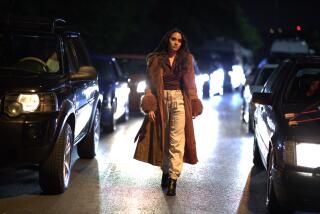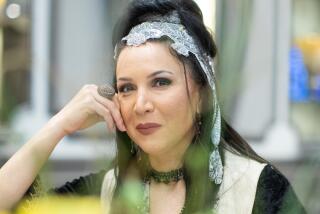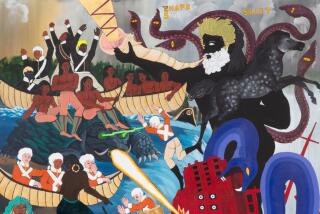For some artists, ‘Focus Iran 3’ show delivers a loud message: ‘We are not alone’
Milad Karamooz’s photograph “The Kiss” depicts two half-naked men. One is seated with eyes closed, a lace harness across his chest and scissor blades across his lips; the other stands behind, a fitted black glove around the seated man’s throat.
The work won third place in the upcoming “Focus Iran 3,” a juried exhibition of 42 contemporary photographs and videos that constitute the third biennial of the Farhang Foundation. The nonprofit, which promotes Iranian arts and culture, chose a theme of Iranian youth culture this year, and the show opens at the newly named Craft Contemporary (formerly the Craft & Folk Art Museum) on Jan. 27. At a ceremony Jan. 25, the top three winners will be awarded cash prizes, although Karamooz won’t be there to accept in person. Discouraged by President Trump’s latest travel ban, the Tehran-based artist didn’t even try to obtain a visa.
It’s not the first challenge Karamooz has faced with this particular work. The photograph, which he said in his artist’s statement addresses growing up “as a minority in a society that is deeply influenced by religion, tradition, patriarchy and violence,” was supposed to be part of a group exhibition in 2016 at Mehrva Art Gallery in Tehran. But government authorities in Iran deemed the subject matter inappropriate and the photograph was eliminated from the show.
I’m getting confirmation that my work is not pointless or futile, and that in fact, I am in a way keeping the art of my country alive.
— artist Milad Karamooz
Mehrva relayed instructions from the government for Karamooz to destroy the work — which he didn’t follow.
“He thought he’d hold on to it and eventually find a better home for it and he sent it to us,” said Farhang’s executive director, Alireza Ardekani. “I was surprised to have an image like this come from Iran, just because of the homoerotic aspect in a country where homosexuality is not only banned, but to the government, it doesn’t exist. An artist being gutsy enough, and provocative enough, to create an image like this, one that’s also so poetic and beautiful, is so inspiring to me.”
Many of the works in the show, by artists largely from the U.S. and Iran but also from France, Italy, Canada and Portugal, touch on sexuality, gender and queer identity. They also reflect on fashion, sports and music, as well as family, government and religion — basically, what it’s like to be young and Iranian today, wherever you are in the world.
Karamooz said it would have been “a dream” to attend the “Focus Iran 3” opening, but he’s not bitter. Simply being accepted into the biennial is one of the proudest moments of his life, he said via email.
“I’m getting confirmation that my work is not pointless or futile, and that in fact, I am in a way keeping the art of my country alive and it’s being seen by the world,” he said.
After the exhibition closes May 12, his photograph will go on view at the Viewpoint Gallery at UC Irvine this fall.
“When something happens on the international stage for us, the meaning of having our art being seen outside of the closed Iranian art society is tremendously meaningful,” he added. “For us to know that we are not alone in our thoughts and expressions outside of our small art world in Iran is so gratifying and fulfilling, and it proves that in our current situation we are not creating art for no reason, and in fact our art has meaning and is worthwhile.”
Follow me on Twitter: @debvankin
More to Read
The biggest entertainment stories
Get our big stories about Hollywood, film, television, music, arts, culture and more right in your inbox as soon as they publish.
You may occasionally receive promotional content from the Los Angeles Times.











